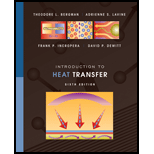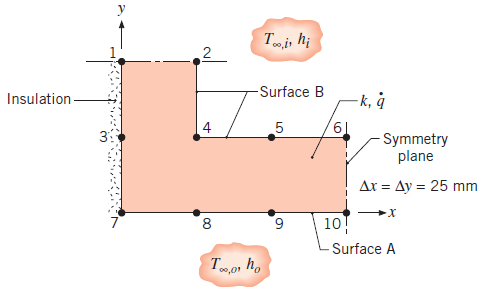
Introduction to Heat Transfer
6th Edition
ISBN: 9780470501962
Author: Frank P. Incropera, David P. DeWitt, Theodore L. Bergman, Adrienne S. Lavine
Publisher: Wiley, John & Sons, Incorporated
expand_more
expand_more
format_list_bulleted
Textbook Question
Chapter 4, Problem 4.57P
Steady-state temperatures at selected nodal points ofthe symmetrical section of a flow channel are knownto be T2=95.47°C, T3=117.3°C, T5=79.79°C, T6=77.29°C, T8=87.28°C, and T10=77.65°C. Thewall experiences uniform volumetric heat generation of .q=106 W/m3 and has a thermal conductivity of k=10 W/m⋅K. The inner and outer surfaces of the channelexperience convection with fluid temperatures of T∞,i=50°C and T∞,o=25°C and convection coefficientsof hi=500 W/m2⋅K and ho=250 W/m2⋅K.

- Determine the temperatures at nodes 1, 4, 7, and 9.
- Calculate the heat rate per unit length (W/m) fromthe outer surface A to the adjacent fluid.
- Calculate the heat rate per unit length from theinner fluid to surface B.
- Verify that your results are consistent with an overallenergy balance on the channel section.
Expert Solution & Answer
Want to see the full answer?
Check out a sample textbook solution
Students have asked these similar questions
3. The volumetric flow rate of air through a duct transition of the type shown in Table 12-9b (rectangular with two parallel sides) is 2 m3/s. The duct before the transition issquare, with a height of 50 cm. The expansion ratio across the transition is 4 (i.e., theduct area after the transition is 4 times greater than the duct area before the transition).a) Determine the pressure loss (in Pa) across the transition if the exit from the duct isabrupt (i.e., the diverging angle of the transition is 180º).b) Determine the percentage reduction in pressure loss for a transition diverging angleof 20º compared to the one in part (a).c) The head HVAC engineer requires the pressure loss across the transition to bereduced to less than 50% of the pressure loss for an abrupt exit (i.e., the case in part(a)), and suggests a transition diverging angle of 45º. Will this new diverging angleachieve the required reduction in pressure loss? Justify your answer.d) For a transition diverging angle of 90º,…
The wheel shown is made of 2 rings and 8 rods. The otter ring weighs 100 lbs, the inner ring weighs 15 lbs,and each of the rods weighs 20 lbs. Find the moment of inertia of the wheel about an axis that comes directlyout of the page through point A.
Mini project
You are an engineer working for a power systems company responsible for ensuring grid
stability. Your team has recently observed low-frequency oscillations in the system following
disturbances such as load changes, faults, and switching operations. These oscillations have
led to voltage instability, frequency deviations, and, in severe cases, system blackouts.
A task force has been formed to address this issue, and you have been assigned a critical
role in developing a damping control strategy. Your objective is to analyze system
performance, propose engineering solutions, and compare the effects of different damping
approaches.
Answer the following questions
1. Identify the Engineering Problem:
- What is the fundamental issue affecting power grid stability?
- How do low-frequency oscillations impact the system's reliability?
- What parameters indicate system instability?
2. Assess the Current Status Using Equations and Calculations:
- Given the characteristic roots of the…
Chapter 4 Solutions
Introduction to Heat Transfer
Ch. 4 - In the method of separation of variables (Section...Ch. 4 - A two-dimensional rectangular plate is subjected...Ch. 4 - Consider the two-dimensional rectangular plate...Ch. 4 - A two-dimensional rectangular plate is subjected...Ch. 4 - Prob. 4.5PCh. 4 - Prob. 4.6PCh. 4 - Free convection heat transfer is sometimes...Ch. 4 - Prob. 4.8PCh. 4 - Radioactive wastes are temporarily stored in a...Ch. 4 - Based on the dimensionless conduction heat rates...
Ch. 4 - Prob. 4.11PCh. 4 - A two-dimensional object is subjected to...Ch. 4 - Prob. 4.13PCh. 4 - Two parallel pipelines spaced 0.5 m apart are...Ch. 4 - A small water droplet of diameter D=100m and...Ch. 4 - Prob. 4.16PCh. 4 - Pressurized steam at 450 K flows through a long,...Ch. 4 - Prob. 4.19PCh. 4 - A furnace of cubical shape, with external...Ch. 4 - Prob. 4.21PCh. 4 - Prob. 4.22PCh. 4 - A pipeline, used for the transport of crude oil,...Ch. 4 - A long power transmission cable is buried at a...Ch. 4 - Prob. 4.25PCh. 4 - A cubical glass melting furnace has exterior...Ch. 4 - Prob. 4.27PCh. 4 - An aluminum heat sink k=240W/mK, used to coolan...Ch. 4 - Hot water is transported from a cogeneration power...Ch. 4 - Prob. 4.30PCh. 4 - Prob. 4.31PCh. 4 - Prob. 4.32PCh. 4 - An igloo is built in the shape of a hemisphere,...Ch. 4 - Consider the thin integrated circuit (chip) of...Ch. 4 - Prob. 4.35PCh. 4 - The elemental unit of an air heater consists of a...Ch. 4 - Prob. 4.37PCh. 4 - Prob. 4.38PCh. 4 - Prob. 4.39PCh. 4 - Prob. 4.40PCh. 4 - Prob. 4.41PCh. 4 - Determine expressions for...Ch. 4 - Prob. 4.43PCh. 4 - Prob. 4.44PCh. 4 - Prob. 4.45PCh. 4 - Derive the nodal finite-difference equations for...Ch. 4 - Prob. 4.47PCh. 4 - Prob. 4.48PCh. 4 - Consider a one-dimensional fin of uniform...Ch. 4 - Prob. 4.50PCh. 4 - Prob. 4.52PCh. 4 - Prob. 4.53PCh. 4 - Prob. 4.54PCh. 4 - Prob. 4.55PCh. 4 - Prob. 4.56PCh. 4 - Steady-state temperatures at selected nodal points...Ch. 4 - Prob. 4.58PCh. 4 - Prob. 4.60PCh. 4 - The steady-state temperatures C associated with...Ch. 4 - A steady-state, finite-difference analysis has...Ch. 4 - Prob. 4.64PCh. 4 - Consider a long bar of square cross section (0.8 m...Ch. 4 - Prob. 4.66PCh. 4 - Prob. 4.67PCh. 4 - Prob. 4.68PCh. 4 - Prob. 4.69PCh. 4 - Consider Problem 4.69. An engineer desires to...Ch. 4 - Consider using the experimental methodology of...Ch. 4 - Prob. 4.72PCh. 4 - Prob. 4.73PCh. 4 - Prob. 4.74PCh. 4 - Prob. 4.75PCh. 4 - Prob. 4.76PCh. 4 - Prob. 4.77PCh. 4 - Prob. 4.78PCh. 4 - Prob. 4.79PCh. 4 - Prob. 4.80PCh. 4 - Spheres A and B arc initially at 800 K, and they...Ch. 4 - Spheres of 40-mm diameter heated to a uniform...Ch. 4 - To determine which parts of a spiders brain are...Ch. 4 - Prob. 4.84P
Knowledge Booster
Learn more about
Need a deep-dive on the concept behind this application? Look no further. Learn more about this topic, mechanical-engineering and related others by exploring similar questions and additional content below.Similar questions
- H.W 4: The beam shown below is subjected to the distributed loading of w=120 kN/m. Determine the principal stresses in the beam at point P, which lies at the top of the web. Neglect the size of the fillets and stress concentrations at this point. I=67.4×10-6 m4. 15 mm w=120 kN/m B 0.3 m 2 200 mm A 10 rim 15 mm 175 mmarrow_forwardA 3 m x 5 m section of wall of the cold room is not insulated, and the temperature at the outer surface of this section is measured to be 7°C. The temperature of the outside room is 30°C, and the combined convection and radiation heat transfer coefficient at the surface of the outer wall is 10 W/m2°C. It is proposed to insulate this section of the furnace wall with glass wool insulation (k = 0.038 W/m°C) in order to reduce the heat transfer by 90%. Assuming the outer surface temperature of the cold room wall section still remains at about 7°C, determine the thickness of the insulation that needs to be used.arrow_forwardQ1/ For what value of x do the power series converge: ∞ Σ(-1)-1 n=1 x2n-1 2n-1 =x x3 3 5 Q2/ Find the Interval of convergence and Radius of convergence of the series : Σ n=1 n 3n+1 (x)" الممسوحة ضوئيا بـ CS CamScannerarrow_forward
- This refrigeration cycle uses R-134a as the working fluid and, for now, assume that it operates on an ideal vapour-compression refrigeration cycle between 0.11 and 1.0 MPa. If the mass flow rate of the refrigerant is 0.075 kg/s, determine What is the rate of heat removal from the refrigerated space? What is the power input to the compressor? What is the rate of heat rejection to the environment? What is the COP of this ideal process? Based on this analysis, what is the cost of electricity to operate the cold room for 1 year? Comment on why this differs to the value above Further data was collected which determined that the working fluid: enters the compressor at 0.11 MPa and -22°C leaves the compressor at 1.0 MPa and 60°C is cooled in the condenser to 0.9 MPa and 20°C is throttled to 0.12 MPa Disregarding any heat transfer or pressure losses in the pipes: What is the rate of heat removal from the refrigerated space? What is the power input to the compressor?…arrow_forward1 The refrigeration capacity of the cold room you are considering is 10 kW. It operates for 24 h/d, 360 days of the year. The average temperature outside the cold room is 30°C and the temperature of the air inside the cold room should be 5°C. What is the maximum coefficient of performance for this refrigeration cycle? What is the minimum work required? and If the price of electricity is 0.008 cents per kJ, what is the minimum cost of electricity to run the cold room for 1 year?arrow_forwardThis refrigeration cycle uses R-134a as the working fluid and, for now, assume that it operates on an ideal vapour-compression refrigeration cycle between 0.11 and 1.0 MPa. If the mass flow rate of the refrigerant is 0.075 kg/s, determine What is the rate of heat removal from the refrigerated space? What is the power input to the compressor? What is the rate of heat rejection to the environment? and What is the COP of this ideal process?arrow_forward
arrow_back_ios
SEE MORE QUESTIONS
arrow_forward_ios
Recommended textbooks for you
 Elements Of ElectromagneticsMechanical EngineeringISBN:9780190698614Author:Sadiku, Matthew N. O.Publisher:Oxford University Press
Elements Of ElectromagneticsMechanical EngineeringISBN:9780190698614Author:Sadiku, Matthew N. O.Publisher:Oxford University Press Mechanics of Materials (10th Edition)Mechanical EngineeringISBN:9780134319650Author:Russell C. HibbelerPublisher:PEARSON
Mechanics of Materials (10th Edition)Mechanical EngineeringISBN:9780134319650Author:Russell C. HibbelerPublisher:PEARSON Thermodynamics: An Engineering ApproachMechanical EngineeringISBN:9781259822674Author:Yunus A. Cengel Dr., Michael A. BolesPublisher:McGraw-Hill Education
Thermodynamics: An Engineering ApproachMechanical EngineeringISBN:9781259822674Author:Yunus A. Cengel Dr., Michael A. BolesPublisher:McGraw-Hill Education Control Systems EngineeringMechanical EngineeringISBN:9781118170519Author:Norman S. NisePublisher:WILEY
Control Systems EngineeringMechanical EngineeringISBN:9781118170519Author:Norman S. NisePublisher:WILEY Mechanics of Materials (MindTap Course List)Mechanical EngineeringISBN:9781337093347Author:Barry J. Goodno, James M. GerePublisher:Cengage Learning
Mechanics of Materials (MindTap Course List)Mechanical EngineeringISBN:9781337093347Author:Barry J. Goodno, James M. GerePublisher:Cengage Learning Engineering Mechanics: StaticsMechanical EngineeringISBN:9781118807330Author:James L. Meriam, L. G. Kraige, J. N. BoltonPublisher:WILEY
Engineering Mechanics: StaticsMechanical EngineeringISBN:9781118807330Author:James L. Meriam, L. G. Kraige, J. N. BoltonPublisher:WILEY

Elements Of Electromagnetics
Mechanical Engineering
ISBN:9780190698614
Author:Sadiku, Matthew N. O.
Publisher:Oxford University Press

Mechanics of Materials (10th Edition)
Mechanical Engineering
ISBN:9780134319650
Author:Russell C. Hibbeler
Publisher:PEARSON

Thermodynamics: An Engineering Approach
Mechanical Engineering
ISBN:9781259822674
Author:Yunus A. Cengel Dr., Michael A. Boles
Publisher:McGraw-Hill Education

Control Systems Engineering
Mechanical Engineering
ISBN:9781118170519
Author:Norman S. Nise
Publisher:WILEY

Mechanics of Materials (MindTap Course List)
Mechanical Engineering
ISBN:9781337093347
Author:Barry J. Goodno, James M. Gere
Publisher:Cengage Learning

Engineering Mechanics: Statics
Mechanical Engineering
ISBN:9781118807330
Author:James L. Meriam, L. G. Kraige, J. N. Bolton
Publisher:WILEY
Heat Transfer – Conduction, Convection and Radiation; Author: NG Science;https://www.youtube.com/watch?v=Me60Ti0E_rY;License: Standard youtube license